Question
S likes which of the
flowers? Answer the questions based on the information given below. Eight persons P, Q, R, S, T, U, V and W are sitting around a circular table facing inside but not necessarily in the same order. All of them likes different flowers viz. Lily, Rose, Marigold, Daisy, Jasmine, Lavender, Lris and Pansy but not necessary in same order. Only one person sits between T and the one who likes Lily. P sits second to the left of the one who likes Lily. W is an immediate neighbour of R. R is not an immediate neighbour of P or T and he does not likes Lavender. T sits second to the left of the one who likes Lavender. Only three people sit between the one who likes Rose and the one who likes Marigold. U sits second to the left of the one who likes Marigold. W does not likes Daisy. The one who likes Daisy is not an immediate neighbor of W. S sits on the immediate left of the one who likes Daisy. The one who likes Lris sits on the immediate right of the one who likes Pansy. Only two persons sit between V and the one who has likes Lavender. The one who likes Rose sits second to the right of W.Solution
Only one person sits between T and the one who likes Lily. P sits second to the left of the one who likes Lily. If the one who likes Lily sits at place no.1, then P sits at place no. 7 and T sits at place no. 3. T sits second to the left of the one who likes Lavender. So, the one who likes Lavender at place no. 5. 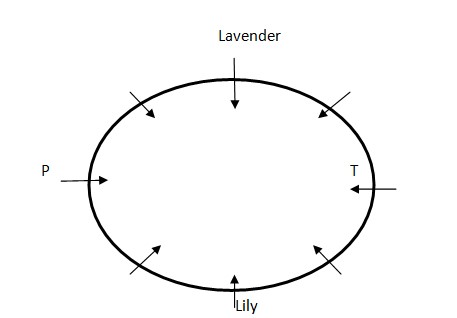 Only two persons sit between V and the one who has likes Lavender. From this statement, we will have two cases: V will sit either at place no. 2 or 8. W is an immediate neighbour of R. R is not an immediate neighbour of P or T and he does not likes Lavender. The one who likes Rose sits second to the right of W. R cannot sit at place no. 6, 5, 4 and 8. So, only place left for him is place no. 1. As W is an immediate neighbour of R. So, W will sit either at place no. 8 or 2. The one who likes Rose sits either at place no. 4 or 2. Only three people sit between the one who likes Rose and the one who likes Marigold. So, the one who likes Marigold sits either at place no. 6 or 8. U sits second to the left of the one who likes Marigold. So, U sits either at place no. 4 or 6. Case-1
Only two persons sit between V and the one who has likes Lavender. From this statement, we will have two cases: V will sit either at place no. 2 or 8. W is an immediate neighbour of R. R is not an immediate neighbour of P or T and he does not likes Lavender. The one who likes Rose sits second to the right of W. R cannot sit at place no. 6, 5, 4 and 8. So, only place left for him is place no. 1. As W is an immediate neighbour of R. So, W will sit either at place no. 8 or 2. The one who likes Rose sits either at place no. 4 or 2. Only three people sit between the one who likes Rose and the one who likes Marigold. So, the one who likes Marigold sits either at place no. 6 or 8. U sits second to the left of the one who likes Marigold. So, U sits either at place no. 4 or 6. Case-1 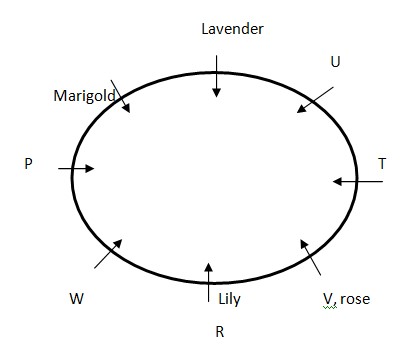 CASE-2
CASE-2 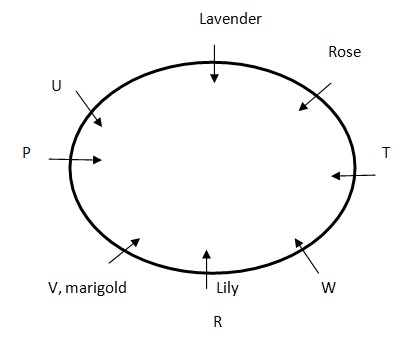 W does not likes Daisy. The one who likes Daisy is not an immediate neighbor of W. S sits on the immediate left of the one who likes Daisy. The one who likes Lris sits on the immediate right of the one who likes Pansy. Case 1 will get discarded as the one who likes Daisy cannot sit at place no. 7 and 8. If the one who likes Daisy sits either at place no. 4 or 3, then there is no place for S as S sits on the immediate left of the one who likes Daisy In case 2, if the one who likes Daisy sits at place no. 6, then S sits at place no. 5. The one who likes Lris and the one who likes Pansy sit at place no. 3 and 2 respectively Only person left for place no. 4 is Q. Only flowers left for P is Jasmine Case-1
W does not likes Daisy. The one who likes Daisy is not an immediate neighbor of W. S sits on the immediate left of the one who likes Daisy. The one who likes Lris sits on the immediate right of the one who likes Pansy. Case 1 will get discarded as the one who likes Daisy cannot sit at place no. 7 and 8. If the one who likes Daisy sits either at place no. 4 or 3, then there is no place for S as S sits on the immediate left of the one who likes Daisy In case 2, if the one who likes Daisy sits at place no. 6, then S sits at place no. 5. The one who likes Lris and the one who likes Pansy sit at place no. 3 and 2 respectively Only person left for place no. 4 is Q. Only flowers left for P is Jasmine Case-1 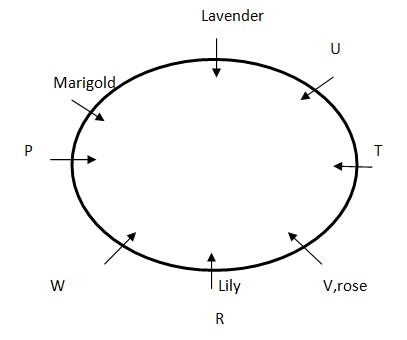 CASE-2
CASE-2 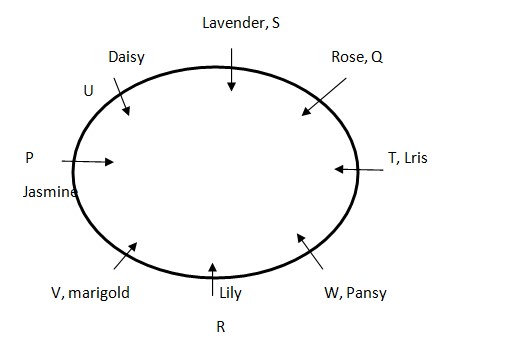 Final arrangement as shown below:
Final arrangement as shown below:
A bag contains ‘x + 2’ red, ‘x + 4’ blue and ‘2x – 2’ green Gloss papers. Two papers are randomly drawn from the bag, so the probability t...
- 5 boys and 3 girls are to be seated on chairs arranged in a row. If the arrangement is made at random, find the probability that no two girls will be seate...
19 rotten bananas are accidentally mixed with 136 good ones. It is not possible to just look at a banana and tell whether or not it is rotten. One banan...
A jar contains 4 violet, 16 cyan and 10 magenta beads. Two beads are randomly drawn from the jar, what is the probability that a violet and a magenta be...
A bag contains 6 red balls, 3 blue balls and 3 green balls. If two balls are drawn randomly, find the probability that none of them is blue or green.
- A money bag has eight 50 paise coins, seven Rs. 2 coins, and ten Rs. 10 coins. If one coin falls out and is lost, what is the probability that the lost coi...
A bag contains 7 yellow balls, 5 black balls and 3 red balls. Two balls are drawn simultaneously. Find the probability that both the balls are of same ...
A bag contains 4 red, 3 blue and 5 green balls (all identical in all respects except colour). One ball is drawn at random. What is the probability that ...
Two letters are selected randomly without replacement from the word ‘PROBABILITY’. Find the probability that both selected letters are consonants.
A jar contains 54 marbles each of which is blue green or white. The probability of selecting a blue marble at random from the jar is 1/3 and the probabi...
Relevant for Exams:



